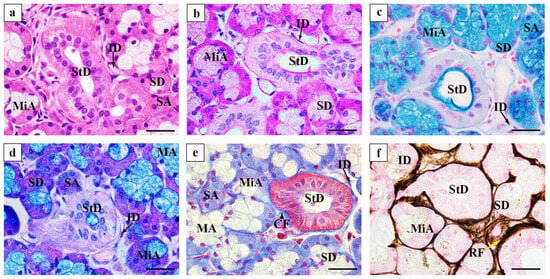The function of the conduit system in SMG includes absorbing sodium and discharging potassium, transporting moisture, etc. Redman et al. [19] discovered that the streak formations on the basal of striated ducts cells consist of mitochondria and folded plasma membrane structures, which increases the surface area of the cell base, facilitating the transport of water and electrolytes between the cell and tissue fluid, such as Na+-ATPase and K+-ATPase involved in liquid and ion transport, indicating that striated tubes can modulate saliva acidity–alkalinity through selective reabsorption and electrolyte secretion [20]. It has been demonstrated that the cytoskeletal system, composed of microfilaments in striated ductal wall cells, plays a role in promoting the contraction of ductal cells to enhance salivary secretion [21]. Consistent with this finding, our study reveals that the cytoskeletal system constructed by microfilaments and mitochondria in SMGs was significantly increased in the striated ducts, which played a major role in the reabsorption and transport of saliva. Fletcher et al. [22] discovered that spindle-shaped myoepithelial cells present in the striated ducts possess mechanical stabilization capabilities and contribute to striated duct contraction mechanisms. Our electron microscopic analysis revealed the close adherence between spindle-shaped myoepithelial cells and the luminal surface of striated ducts assisting in the efficient expulsion of saliva. ZHOU et al. [11] proposed that the junction complex between ductal cells composed of desmosomes, intermediate junctions, and tight junctions serves as a fundamental element for glandular function. Lee et al. [23] demonstrated that the perforated capillaries in SMGs contribute to substance permeability and differentiation, and the development of acinar cells. In the present study, the connectivity complex between striated endothelial cells and the capillaries adjacent to the acini, facilitates the drainage of mucinous acini and ion-selective exchange. The antibodies generated by Pc can mediate humoral immunity [24]. The Pc in the salivary gland microenvironment produces autoantibodies and is not dependent on B cell activation and differentiation [25]. Kathrine Skarstein et al. [26] demonstrated that plasma cells from patients with primary dry syndrome actively contribute to inflammation recovery in salivary glands [26]. The Mø, immune cells originating from bone marrow, are distributed across various tissues for phagocytosis and degradation of dead cells, debris, and foreign substances while coordinating inflammatory processes [27]. Mø plays a pivotal role during tissue injury repair by participating in the initiation, maintenance, and regression phases [28]. In this study, the typical structural characteristics of Pc and Mø may significantly contribute to maintaining stability in the Bactrian camel’s SMG microenvironment.
Source link
Yulu Chen www.mdpi.com



